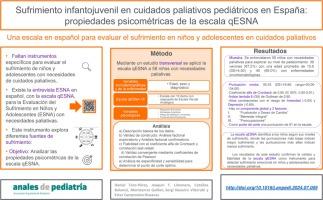西班牙儿科姑息关怀中的儿童和青少年痛苦:qESNA量表的心理测量特性
IF 1.5
4区 医学
Q2 PEDIATRICS
引用次数: 0
摘要
方法对西班牙的 58 名患者(女性,32.8%;平均年龄 15.6 [标码,4.5];年龄范围 8-23 岁)进行横断面和纵向研究,同时使用 qESNA 量表和其他量表来评估焦虑、抑郁、情绪变化和心理社会功能。我们进行了探索性和确认性因子分析,并计算了拟合优度指数;我们通过克朗巴赫α评估了信度,通过类内相关系数评估了时间稳定性和收敛效度,并通过ROC曲线评估了特异性和敏感性。结果因子分析确定了一个包含 3 个因子的 14 项量表,比较拟合指数为 0.93,塔克-刘易斯指数为 0.91,均方根近似误差为 0.07,克隆巴赫α为 0.85,类内相关系数为 0.66。与抑郁风险(-0.69)、焦虑(-0.60)和情绪变化(-0.59)的相关性较高。ROC曲线分析表明,得分低于81分将表明患儿遭受痛苦,其敏感性为83.33%,特异性为93.48%。结论这项研究证实了qESNA量表具有良好的心理测量学特性,该量表可作为临床实践中检测患有生命垂危或危及生命疾病患儿情绪痛苦的工具。本文章由计算机程序翻译,如有差异,请以英文原文为准。

Sufrimiento infantojuvenil en cuidados paliativos pediátricos en España: propiedades psicométricas de la escala qESNA
Objective
To analyze the psychometric properties of the qESNA scale and its usefulness to assess the suffering of paediatric patients with life-limiting and/or life-threatening diseases (children with LLTC) in clinical practice.
Methods
Cross-sectional and longitudinal study in 58 patients in Spain (female, 32.8%; mean age, 15.6 [SD, 4.5]; age range, 8-23 years), with administration of the qESNA scale along with other scales to assess anxiety, depression, emotional changes and psychosocial functioning. We performed exploratory and confirmatory factor analyses and calculated goodness-of-fit indices were calculated; we assessed reliability by means of the Cronbach alpha and temporal stability and convergent validity through the intraclass correlation coefficient with scales used to assess psychological disorders and the specificity and sensitivity through ROC curves.
Results
The factor analysis identified a 14-item scale with 3 factors, a comparative fit index of 0.93, a Tucker-Lewis index of 0.91 and a root mean square error of approximation of 0.07. the Cronbach alpha was 0.85 and the intraclass correlation coefficient was 0.66. The convergent validity was high for the correlation to the risk of depression (−0.69) and of anxiety (−0.60) and emotional changes (−0.59). The analysis of the ROC curves showed that a score of less than 81 would be indicative of suffering, with a sensitivity of 83.33% and a specificity of 93.48%.
Conclusions
This study confirmed that the psychometric properties of the qESNA scale are good and the scale's usefulness as an instrument to detect emotional suffering in children with life-limiting or life-threatening illnesses in clinical practice.
求助全文
通过发布文献求助,成功后即可免费获取论文全文。
去求助
来源期刊

Anales de pediatria
医学-小儿科
CiteScore
2.10
自引率
4.80%
发文量
155
审稿时长
44 days
期刊介绍:
La Asociación Española de Pediatría tiene como uno de sus objetivos principales la difusión de información científica rigurosa y actualizada sobre las distintas áreas de la pediatría. Anales de Pediatría es el Órgano de Expresión Científica de la Asociación y constituye el vehículo a través del cual se comunican los asociados. Publica trabajos originales sobre investigación clínica en pediatría procedentes de España y países latinoamericanos, así como artículos de revisión elaborados por los mejores profesionales de cada especialidad, las comunicaciones del congreso anual y los libros de actas de la Asociación, y guías de actuación elaboradas por las diferentes Sociedades/Secciones Especializadas integradas en la Asociación Española de Pediatría.
 求助内容:
求助内容: 应助结果提醒方式:
应助结果提醒方式:


